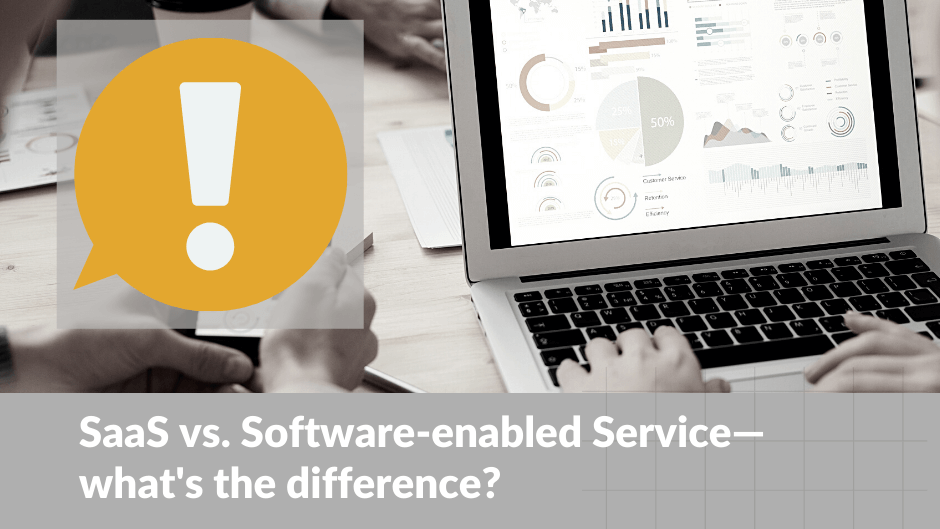First coined in 2005 as a new business model, SaaS continues evolving into a widely accepted delivery method for software solutions. In this guide, we’re discussing SaaS vs Software-enabled Service, their differences, and the benefits of these services and solutions.
SaaS vs Software-Enabled Service: The Difference
While these two acronyms look similar because they both use the word “software,” there are significant differences between them. In the first, SaaS (Software as a Service), the business model involves selling software. In the second, SeS (Software Enabled Service) uses software as a critical aspect of the business model.
SaaS: Selling Software is the Business
SaaS is a software delivery system allowing users to connect to and use data access from any device using the cloud. As long as the device has a web browser and an internet connection, access is possible. It’s the software vendor’s responsibility to host and maintain the code, databases, and servers. In other words, these vendors’ business includes writing and selling the software businesses need to run their business.
SeS: Software is an Aspect of the Business
While a SaaS is a software delivery system, a SeS uses software as a critical component of the services they offer. What that means is that the SeS uses software when providing services to a company. They’re using services to amplify the importance or value of the software. Ultimately, customers partner with an expert (the SeS company) to reap the most benefits from the software and achieve their desired results.
SaaS vs Software-enabled Service: The Importance of Software-Enabled Service
While digital transformation is critical for businesses, it also causes a significant amount of confusion. Executives don’t deny its importance; there are often questions regarding approaching it and where to start. For example, a company might download software intended to enhance productivity. Instead, that decision does nothing more than bring frustration. The learning curve may be steeper than expected, resulting in delays, errors, and lost revenue.
Companies can use a SeS partnership to help them get up to speed with SaaS solutions quicker. If you believe your employees don’t have time to learn a new software solution or troubleshoot issues, it might be time to look at a SeS partnership. That way, staff members can focus on the business’s objectives instead of the software that helps achieve them.
The Benefits of SaaS
SaaS offers unique benefits to businesses that don’t want to use standard software installations. Of the many benefits of SaaS, companies don’t have to worry about building a server, installing software, or troubleshooting configurations. Here are some other notable benefits:
Ease of Use
Companies do not need to spend a significant amount of time or money onboarding staff onto new software solutions, thanks to the easy-to-use application nature of SaaS. Reduce training time thanks to the service’s highly intuitive features.
Integration
Because SaaS solutions are available in the cloud, they integrate easily with other SaaS solutions. That means businesses don’t have to purchase additional software or servers. They only need to enable the new solution and scale it according to their specific needs.
Reduce Costs
Using software on legacy systems involves spending money on the software and the time it takes to install. Because SaaS operates over the cloud, that helps companies reduce their overall costs.
Use Services Immediately
It can take a significant amount of time to install and maintain new software solutions. However, with SaaS, companies can use services immediately via the cloud.
Final Thoughts About SaaS vs Software-enabled Service
Keep in mind that even though there are many differences between SaaS vs. Software-enabled Service, that doesn’t mean you should focus solely on one solution to achieve your business objectives. Instead, consider taking a hybrid approach involving a mix of SaaS and SeS, depending on the outcomes you hope to achieve. For example, if your company needs data center consolidation or source code management, remember that one is a capability and the other is a service.
FAQ About SaaS vs Software-enabled Service
What is the difference between SaaS vs Software-enabled Service?
SaaS (Software as a Service) focuses on using the software as the core part of the business model. In contrast, SeS (Software Enabled Service) uses software to help businesses achieve their goals.
What are software-enabled services?
Software-enabled services mean providers use software to provide critical services to companies.
What’s the difference between the cloud and software as a service SaaS?
While cloud and SaaS are closely related, there are notable differences. Cloud-based software is mainstream and includes applications ranging from ERP solutions like NetSuite to organizational solutions like ClickUp and Asana.
SaaS involves licensing cloud-based applications to users. Users access the software via a web browser and internet connection. Therefore, there’s no need for them to install or maintain software locally. Typically, SaaS applications feature subscription-based licensing.
What is the difference between SaaS and managed services?
Managed services differ from SaaS in that they take the software solution a step further by offering companies support, which often includes taking care of hardware and networking requirements.
